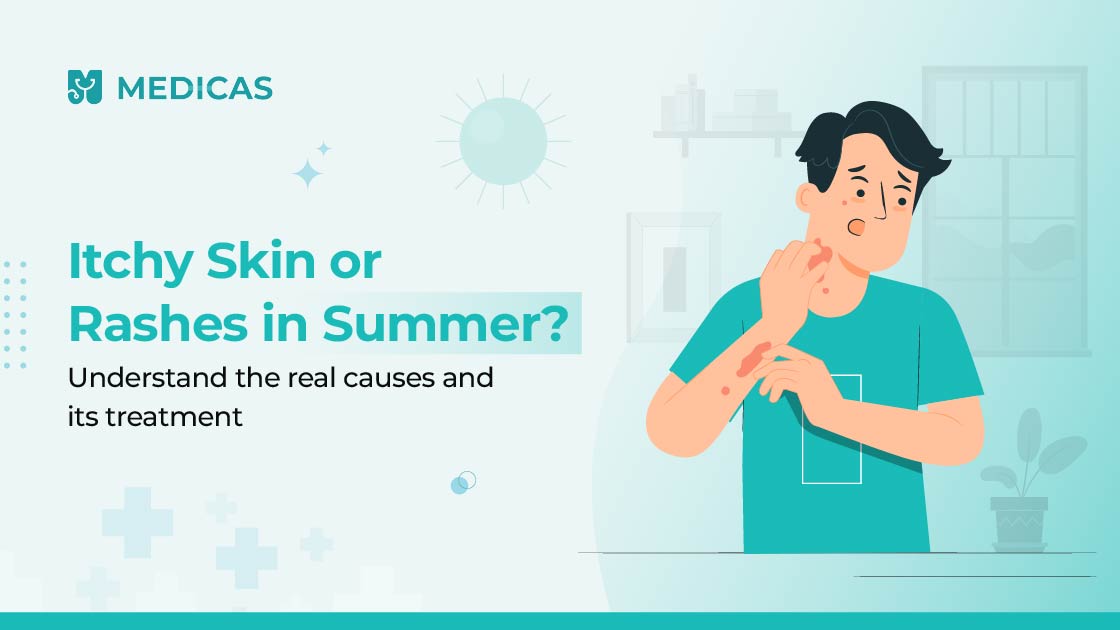Sun’s out, sleeves are up—and suddenly, your skin’s itching like crazy or breaking out in mysterious rashes. Sound familiar? Warm weather may feel great, but it can also bring along a few unwelcome skin surprises. From heat rashes to skin allergies and sweat-induced irritation, summer can be tough on your skin. But don’t worry—most of these issues are easy to handle once you know what’s behind them. This blog explains why skin rashes in summer occur, how to tell them apart, when treatment helps—and when to seek expert care.
Common Causes of Itchy Skin in Summer
When the mercury rises, several factors can trigger itchy skin and summer rashes:
Heat Rash (Prickly Heat) and Sweat Trapping
Also called prickly heat or heat rash, this appears when sweat ducts clog, trapping sweat under the skin. Small, red, itchy papules often emerge in skin folds, under tight clothing, or where friction occurs. Infants and young children are especially susceptible due to their underdeveloped sweat glands.
Fungal Infections Due to Humidity
The humid conditions prevalent in summer provide an ideal breeding ground for fungi. Fungal infections, such as ringworm (tinea corporis), jock itch (tinea cruris), and athlete’s foot (tinea pedis), thrive in warm, moist environments. These infections often present as red, itchy, scaly patches, sometimes with a raised border.
Sun Allergies and Photosensitivity
While the sun is essential for vitamin D synthesis, for some individuals, exposure to sunlight can trigger an allergic reaction, leading to skin rashes in summer. This phenomenon is known as photosensitivity or sun allergy. Polymorphous light eruption (PMLE) is a common type of sun allergy, characterized by an itchy, bumpy, or blister-like rash that appears hours or days after sun exposure. Certain medications can also make your skin more sensitive to the sun, leading to a similar reaction.
Skin Allergies from Fabrics, Lotions, or Pools
Our exposure to various substances increases in summer, raising the likelihood of contact dermatitis, a type of skin allergy. New swimsuits, sunscreen lotions, insect repellents, or even the chemicals used in swimming pools (like chlorine) can trigger an allergic reaction in sensitive individuals. This typically presents as an itchy skin rash, redness, and sometimes swelling, appearing at the point of contact with the offending substance. Carefully observing when and where the skin allergy appears can help identify the culprit.
How to Differentiate Between Summer Rashes
Understanding how to treat summer rashes begins with accurate identification:
| Feature | Heat Rash | Fungal Infection | Sun Allergy | Contact Allergy |
| Onset | Hot, sweaty conditions | Prolonged humidity | Sun exposure | Contact with irritant/allergen |
| Appearance | Fine red papules, prickling | Scaly, circular patches | Hives, blotchy red bumps | Red, itchy patches or blisters |
| Location | Skin folds, under clothes | Feet, groin, under breasts | Exposed areas (arms, chest, face) | Where the irritant touches the skin |
| Itchiness | Mild to moderate | Intense | Moderate to severe | Severe |
| Resolution | 1–3 days with cooling | Weeks with antifungals | Days with sun avoidance | Days with irritant removal |
Effective Treatment and Home Remedies
Most summer skin issues improve with conservative measures and home remedies:
- Cool Compresses: Apply damp, cool cloths to soothe prickly heat or sun rash.
- Air Flow and Loose Clothing: Wear breathable cotton to reduce sweat trapping.
- Topical Calamine or Menthol Lotions: Relieve itching and dryness.
- Oatmeal Baths: Colloidal oatmeal calms inflamed skin—ideal for generalized itch.
- Aloe Vera Gel: Natural cooling agent for sunburn and mild skin allergies.
- Avoid Irritants: Switch to fragrance-free detergents, patch-test new lotions.
- Stay Hydrated: Proper fluid intake supports skin repair.
For persistent or severe cases, consider an online doctor consultation or book lab test (skin scraping or allergy panel) for precise diagnosis.
When to See a Dermatologist
If symptoms persist longer than two weeks—even with remedies—or are accompanied by:
- Spreading rash or irritation
- Severe itch interfering with daily tasks
- Pus, bleeding, or signs of infection
- Recurring issues despite precautions …it’s time to book an appointment with dermatologist or opt for an online doctor consultation.
Preventing Summer Skin Issues
Staying itch-free during summer is possible with regular care:
- Regular Showering: Especially after sweating or swimming
- Stay Cool: Stay in shaded areas, use fans/air-conditioning
- Change Damp Clothes Promptly: Avoid prolonged moisture against the skin
- Apply Broad-Spectrum Sunscreen: Reapply every two hours to thwart sun allergy
- Use Gentle Products: Non-comedogenic lotions, mild laundry detergents
- Maintain a Healthy Weight: Reduces skin fold friction
Beyond just rashes, summer heat and humidity can also sometimes worsen other common skin concerns. If you find yourself battling sudden breakouts, especially when sweat and oil production are higher, you might find effective relief and strategies in: “How to Get Rid of Pimples Overnight: 11 Quick Remedies.” For deeper insights on managing skin in hot climates, see Understanding the Causes of Dark Neck Skin and Understanding Acne: Causes, Treatments, and Myths for related guidance on pigmentation and acne triggered by sweat.
Conclusion
Skin rashes in summer and itchy skin need not spoil the season. By pinpointing what causes itchy skin in summer, applying targeted home remedies, and tweaking daily habits, most summer rashes resolve quickly. For stubborn or severe cases, an online doctor consultation through Medicas or a visit to the clinic can ensure the right treatment. Don’t let summer discomfort linger—take action early and enjoy the sunshine worry-free.
Frequently Asked Questions (FAQs)
- What are the main causes of itchy skin in the Summers?
Common culprits include heat rash, fungal infections from humidity, sun allergies, and contact allergies from fabrics or chemicals.
- How do I know if it’s a heat rash or a fungal infection?
Heat rashes or skin rashes in summer appear as tiny red papules in sweat-prone areas and improve with cooling. Fungal infections form scaly, ring-shaped patches, often in warm, moist body folds. Refer to the differentiation table above for details.
- Can summer rashes be prevented?
Yes—keep skin cool and dry, wear breathable fabrics, apply sunscreen, switch to gentle detergents, and shower after sweating or swimming.
- When should I see a doctor for a skin rash?
Consult a dermatologist if the rash is widespread, intensely itchy, shows signs of infection, or fails to improve after one to two weeks of home care. You can easily book appointment with dermatologist through Medicas for expert evaluation.
- Can I get help for skin rashes without visiting a clinic?
Absolutely. An online doctor consultation through Medicas can assess your rash via photos or video, recommend how to treat summer rashes, and prescribe medications or tests if needed.
Disclaimer
Medical Advice: The information provided in this blog post is for educational purposes only and should not be considered as a substitute for professional medical advice, diagnosis, or treatment. Always consult with a qualified healthcare professional for personalized guidance regarding your specific medical condition.
Accuracy of Information: While we strive to provide accurate and up-to-date information, the field of medicine and viral fevers is constantly evolving. The content in this blog post may not reflect the most current research or medical guidelines. Therefore, it is advisable to cross-check any information provided with reliable sources or consult a healthcare professional.
Individual Variations: The symptoms, causes, treatment options, and preventive measures discussed in this blog post are general in nature and may not apply to everyone. It is important to remember that each individual’s situation is unique, and personalized medical advice should be sought when making healthcare decisions.
External Links: This blog post may contain links to external websites or resources for additional information. However, we do not endorse or have control over the content of these third-party websites. Accessing these links is done at your own risk, and we are not responsible for any consequences or damages that may arise from visiting these external sources.
Results May Vary: The effectiveness of treatment options or preventive measures mentioned in this blog post may vary from person to person. What works for one individual may not work the same way for another. It is essential to consult with a healthcare professional for personalized advice tailored to your specific needs.



